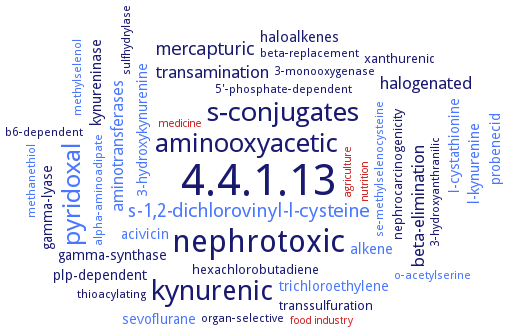Please wait a moment until all data is loaded. This message will disappear when all data is loaded.
Please wait a moment until the data is sorted. This message will disappear when the data is sorted.
C117G
-
inactive protein, pyridoxal 5'-phosphate is not detectable in the mutant protein, enhanced susceptibility to chymotrypsin digestion
C279
-
activity is comparable with that of the native enzyme
C309A
-
inactive protein, pyridoxal 5'-phosphate is not detectable in the mutant protein, enhanced susceptibility to chymotrypsin digestion
C88A
-
activity is comparable with that of the native enzyme
D116A
-
mutant with reduced catalytic efficiency
D116N
-
mutant with reduced catalytic efficiency
F55D
-
the mutant shows 74fold reduced catalytic efficiency compared to the wild type enzyme
F55D/Y338E
-
the mutant shows 58000fold reduced catalytic efficiency compared to the wild type enzyme
K42A
site-directed mutagenesis, the mutant shows slightly reduced catalytic efficiency compared to the wild-type enzyme
R372A
-
mutant with reduced catalytic efficiency
R372K
-
mutant with reduced catalytic efficiency
R372L
-
mutant with reduced catalytic efficiency
R58A
-
mutant with reduced catalytic efficiency
R58K
-
mutant with reduced catalytic efficiency
R59A
-
mutant with reduced catalytic efficiency
R59K
-
mutant with reduced catalytic efficiency
S32A
site-directed mutagenesis, the mutant shows slightly reduced catalytic efficiency compared to the wild-type enzyme
S33A
site-directed mutagenesis, the mutant shows slightly reduced catalytic efficiency compared to the wild-type enzyme
W131F
site-directed mutagenesis, below 2fold increase in KM and kcat for L-cystathionine and by less than 1.7°C reduced midpoint of thermal denaturation, monitored by circular dichroism spectroscopy, compared to the wild-type enzyme
W131F/W188F/W230F/W276F
site-directed mutagenesis, below 2fold increase in KM and kcat for L-cystathionine and by less than 1.7°C reduced midpoint of thermal denaturation, monitored by circular dichroism spectroscopy, compared to the wild-type enzyme
W131F/W188F/W230F/W276F/W300F
site-directed mutagenesis, below 2fold increase in KM and kcat for L-cystathionine and by less than 1.7°C reduced midpoint of thermal denaturation, monitored by circular dichroism spectroscopy, compared to the wild-type enzyme
W131F/W188F/W230F/W276F/W340F
site-directed mutagenesis, below 2fold increase in KM and kcat for L-cystathionine and by less than 1.7°C reduced midpoint of thermal denaturation, monitored by circular dichroism spectroscopy, compared to the wild-type enzyme
W131F/W188F/W230F/W300F/W340F
site-directed mutagenesis, below 2fold increase in KM and kcat for L-cystathionine and by less than 1.7°C reduced midpoint of thermal denaturation, monitored by circular dichroism spectroscopy, compared to the wild-type enzyme
W131F/W188F/W276F/W300F/W340F
site-directed mutagenesis, below 2fold increase in KM and kcat for L-cystathionine and by less than 1.7°C reduced midpoint of thermal denaturation, monitored by circular dichroism spectroscopy, compared to the wild-type enzyme
W131F/W230F/W276F
site-directed mutagenesis, below 2fold increase in KM and kcat for L-cystathionine and by less than 1.7°C reduced midpoint of thermal denaturation, monitored by circular dichroism spectroscopy, compared to the wild-type enzyme
W131F/W230F/W276F/W300F
site-directed mutagenesis, below 2fold increase in KM and kcat for L-cystathionine and by less than 1.7°C reduced midpoint of thermal denaturation, monitored by circular dichroism spectroscopy, compared to the wild-type enzyme
W131F/W230F/W276F/W300F/W340F
site-directed mutagenesis, below 2fold increase in KM and kcat for L-cystathionine and by less than 1.7°C reduced midpoint of thermal denaturation, monitored by circular dichroism spectroscopy, compared to the wild-type enzyme
W131F/W230F/W276F/W340F
site-directed mutagenesis, below 2fold increase in KM and kcat for L-cystathionine and by less than 1.7°C reduced midpoint of thermal denaturation, monitored by circular dichroism spectroscopy, compared to the wild-type enzyme
W188F
site-directed mutagenesis, below 2fold increase in KM and kcat for L-cystathionine and by 4.7°C reduced midpoint of thermal denaturation, monitored by circular dichroism spectroscopy, compared to the wild-type enzyme
W188F/W230F/W276F/W300F/W340F
site-directed mutagenesis, below 2fold increase in KM and kcat for L-cystathionine and by less than 1.7°C reduced midpoint of thermal denaturation, monitored by circular dichroism spectroscopy, compared to the wild-type enzyme
W230F
site-directed mutagenesis, below 2fold increase in KM and kcat for L-cystathionine and by less than 1.7°C reduced midpoint of thermal denaturation, monitored by circular dichroism spectroscopy, compared to the wild-type enzyme
W276F
site-directed mutagenesis, below 2fold increase in KM and kcat for L-cystathionine and by less than 1.7°C reduced midpoint of thermal denaturation, monitored by circular dichroism spectroscopy, compared to the wild-type enzyme
W300F
site-directed mutagenesis, below 2fold increase in KM and kcat for L-cystathionine and by less than 1.7°C reduced midpoint of thermal denaturation, monitored by circular dichroism spectroscopy, compared to the wild-type enzyme
Y338E
-
the mutant shows 2850fold reduced catalytic efficiency compared to the wild type enzyme
K233A
site-directed mutagenesis, the mutant is only active with D-Ser, but inactive with L- or D-Cys, and L-Ser, in contrast to the wild-type enzyme
Y123A
site-directed mutagenesis, the mutant shows highly reduced activity with L-Cys compared to the wild-type enzyme, and is active with L-Ser in contrast to wild-type
K233A
-
site-directed mutagenesis, the mutant is only active with D-Ser, but inactive with L- or D-Cys, and L-Ser, in contrast to the wild-type enzyme
-
Y123A
-
site-directed mutagenesis, the mutant shows highly reduced activity with L-Cys compared to the wild-type enzyme, and is active with L-Ser in contrast to wild-type
-
K223A
-
inactive mutant enzyme
additional information
construction of 12 chimeric mutants of cystathionine gamma-synthase, EC 2.5.1.48, and cystathionine beta-lyase to probe the roles of two structurally distinct, about 25-residue segments situated in proximity to the amino and carboxy termini and located at the entrance of the active-site. The exchange of the targeted regions impairs the activity of the resulting enzymes, but does not produce a corresponding interchange of reaction specificity, catalytic efficiency of the native reactions is reduced by at least 95fold, and alpha,beta versus alpha,gamma-elimination specificity is not modified. The chimeric enzymes adopt a stable folded structure
W340F

-
mutant with reduced catalytic efficiency
W340F
site-directed mutagenesis, 8fold ncrease in KM for L-cystathionine compared to the wild-type enzyme




 results (
results ( results (
results ( top
top






